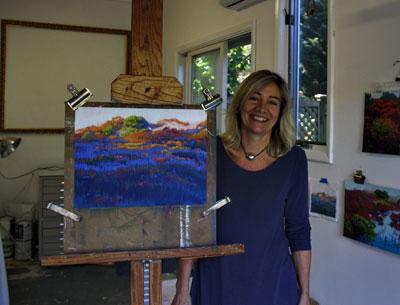Mary Daunt’s Pastels

It was while driving back and forth from Montauk to her job at VJS Studio in East Hampton that Mary Daunt realized what an unusual landscape lies on either side of Montauk Highway and in Montauk generally. “The light is a lot more intense in the early fall. I prefer fall colors — there’s so much contrast between the red and green and the blue and orange.” Montauk’s landscape “is wilder,” she said.
As she worked, she found that she was better able to achieve her interest in “pushing the color rather than the detail” by using pastels, which “worked better for me, I found a technique that helps me build a lot of layers. When you cover the surface with pastel, it’s a painting. When you sketch on paper and let it show through, it’s a drawing.” Seen from a slight distance, her landscapes look like oil paintings.
“Oil paint is to acrylic what butter is to margarine,” Ms. Daunt said, but she has come to prefer pastels, which were “always my favorite medium. You can leave it set up, there is no mixing of colors, no taking it down. It is very immediate gratification.”
Growing up in York, Pa., Ms. Daunt visited the Jersey Shore as a child and first came to the East End with a pal from art school. She fell in love with Montauk, eventually moving there about 35 years ago.
She has shown her work at East End galleries since 1996 as well as at the Box Art Auction. In 2011 The New York Times featured a painting she did for “America the Beautiful,” an exhibition at the Southampton Cultural Center curated by Arlene Bujese.
Even when she wasn’t able to make the time to do her artwork, “it was always in my head,” Ms. Daunt said. As her children have become more independent, she has been able to devote more time to painting landscapes and still lifes and especially to art restoration, cleaning out her Montauk garage of all the stuff that had been stored there and making it her studio.
While landscapes make up much of her work, she said she rarely works outside. To avoid the temptation of focusing on detail as opposed to experimenting with color, she works mainly from photographs, on museum-grade sanded paper. Sometimes she puts a piece aside because she doesn’t like it or it’s not working, and comes back to it years later with a fresh eye. “I finish it without photo reference and it turns out to be one of my favorites.”
She sees abstraction and realism as a continuum. “I don’t think you can really separate the abstract components from the realistic . . . the abstract qualities of a painting are always there, even in realistic works. There is a balance between the two things.”
For subject matter, she prefers Montauk’s more untamed vegetation to farms or other landscapes. “Farm fields are too finished. . . . In a farm field, how do you get reds? It’s all about the light and shadow. Your eye needs points of interest and places to rest.”
